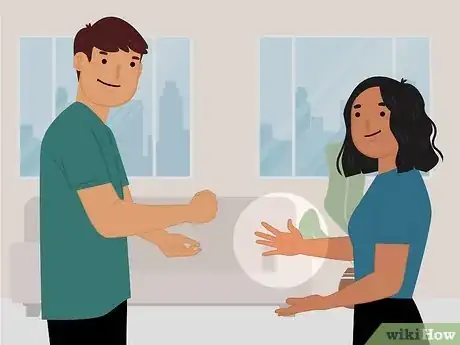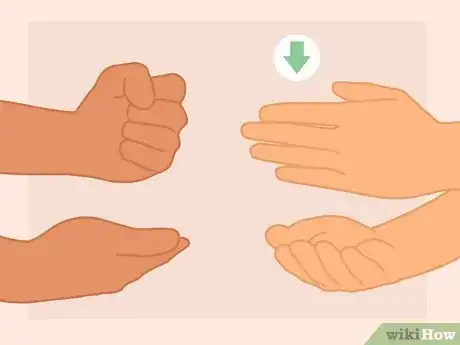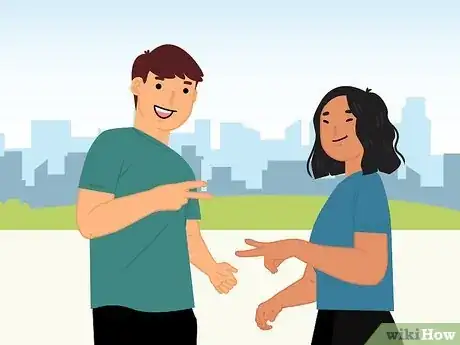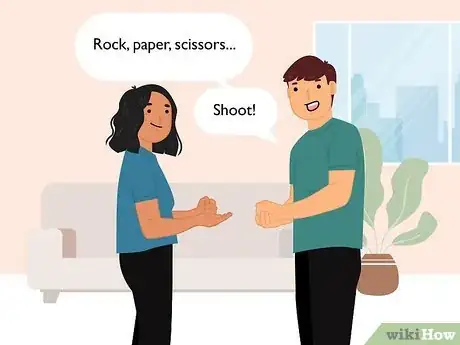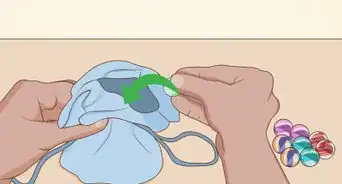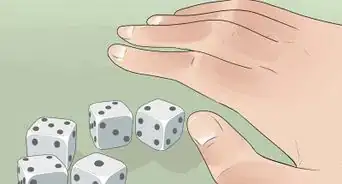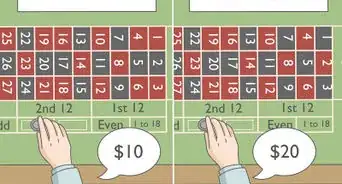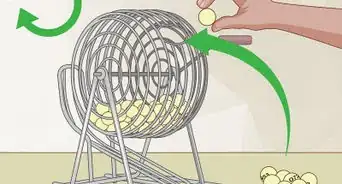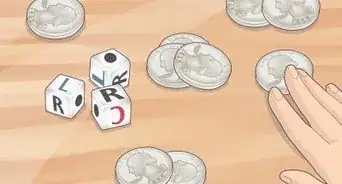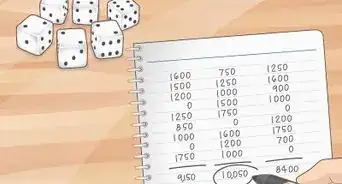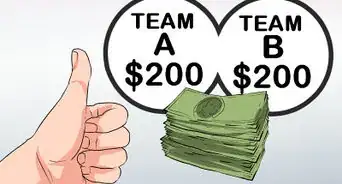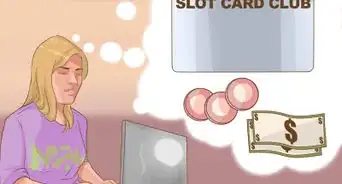This article was co-authored by wikiHow staff writer, Luke Smith, MFA. Luke Smith is a wikiHow Staff Writer. He's worked for literary agents, publishing houses, and with many authors, and his writing has been featured in a number of literary magazines. Now, Luke writes for the content team at wikiHow and hopes to help readers expand both their skillsets and the bounds of their curiosity. Luke earned his MFA from the University of Montana.
There are 8 references cited in this article, which can be found at the bottom of the page.
This article has been viewed 1,107,590 times.
Learn more...
Rock, Paper, Scissors is often used to decide everything from who’s buying lunch to who has to wash the dishes. While the game is primarily decided by chance and there’s no surefire to win every time, there is a fair amount of strategy you can use to improve your odds, and maybe avoid dishwashing duties while you’re at it. We’ll walk you through how to win against both rookies and pros, as well as how to get the game started. And while these are some serious strategies, just remember that the game is for fun!
Things You Should Know
- Throw paper against men, and throw rock against women, since inexperienced men and women are themselves more likely to throw rock and scissors, respectively.
- Switch up your own move after your opponent plays the same move twice—if they play rock twice, they may play paper next, so play scissors yourself.
- Manipulate your opponent by miming the move you want them to throw while you explain the rules, or by announcing which move you’ll throw next.
- Take advantage of physical tells that might indicate your opponent’s next move, like a tucked thumb for a rock, or a loosened grip for paper.
Steps
Playing a Rookie
-
1Throw paper against a male opponent. Statistically, inexperienced men most often lead with rock as their first move in a game of Rock, Paper, Scissors. By throwing paper on your first move against them, you’re more likely to win.[1]
- Statistically, rock is the most frequent move, with a throw rate of 35.4%.
-
2Throw rock against a female opponent. Studies show that most women tend to lead with scissors, so if you throw out a rock on the first play of the game you may beat your opponent.[2]
- Scissors is the throw that’s used the least, with only a 29.6% chance of being thrown in an average Rock, Paper, Scissors game.
Advertisement -
3Switch your move after your opponent plays the same hand twice in a row. If your opponent plays the same move twice in a row, they’re not likely to use it a third time. Assume they won’t throw that move again and, statistically, that they’ll throw the next move in the rock-paper-scissors sequence.[3] Throw a move that will trump the hand in the sequence that comes after the one they just threw.
- For example, after your opponent has played scissors twice in a row, they’ll most likely move on to rock. Throw paper because it will either beat your opponent’s rock—or result in a stalemate in the event they choose paper.
-
4Suggest a throw to your opponent when explaining the game. If your rookie opponent needs a quick review of the rules, use hand gestures to subconsciously suggest to them their first move. Repeatedly miming a particular move with your hands makes your opponent more likely to subconsciously throw that move.[4]
- For example, explain that rock beats scissors using the scissors gesture to show this (instead of rock), and then use the scissors gesture again when explaining that scissors beats paper. This will subtly influence them to play scissors, so be prepared to throw rock!
Playing Experienced Opponents
-
1Play scissors in the first round. Experienced players who know the statistics probably won’t throw a rock for their first move, so lead with scissors. This way you can beat their paper or tie if they also lead with scissors. [5]
- Experienced players also tend to think that beginners will most likely throw a rock, so the experienced player often throws paper. Throwing scissors will place you one step ahead of their thinking.
-
2Switch moves if you lose. We like to stick with what works, meaning that if your opponent just won, they’ll most likely throw the same move they just won with, so switch your own move to whichever both trumps or stalemates that move.[6]
- For example, if your opponent just beat you with rock, switch your next move to paper to beat the rock that your opponent will likely use again, or stalemate the less likely scissors.
-
3Take advantage of tells like tucked thumbs or unclenched hands. Opponents often have tells in the way they position their hands that will let you know which move they might be planning, and many pros use these tells to decide their next move. They’re not easy to spot, and everyone has different tells, but with a little practice and familiarity, you can catch on to your opponent’s moves.[7]
- For example, a tucked thumb in the crook of the index finger might suggest that your opponent will throw rock.
- A loose, unclenched hand may indicate paper.
- A hand that has the first two fingers loose is likely going to be scissors.
-
4Announce your throw. It’s reverse psychology—tell your opponent you’re about to throw rock, and they’ll think you're bluffing and that you plan to throw something else. They’ll likely choose something that beats either paper or scissors. Then, you actually do throw rock, resulting in either a win or a stalemate.[8]
- This will only work once or twice before your opponent catches on, so after a couple of times, switch up your tactic. Announce something that you won’t actually throw to keep them on their toes.
-
5Throw paper if your opponent gets frustrated. If your opponent is repeatedly losing, they’re more likely to throw rock, since this is symbolically a very aggressive option that players rely on when losing. Throwing paper will beat their rock.[9]
- On the other hand, paper is seen as the most passive move, so don’t expect this from an opponent who’s losing.
-
6Throw paper for the statistically superior move. When you’re at a loss of what to do, throw paper. Because scissors is the least thrown move, statistically, and because rock is the most thrown move, paper is the safest way to go.[10]
Learning the Basic Rules
-
1Find a partner and decide how many rounds you’ll play. Rock, paper, scissors is played with two people, so find a partner to play with before you begin. Then, choose an odd number of rounds that you’ll play. By choosing an odd number, you’ll avoid ties and ensure a winner.[11]
- Rock, Paper, Scissors is often played as a “best of 3” game, meaning whoever wins at least 2 out of 3 rounds wins the overall game.
-
2Memorize that rock beats scissors, scissors beats paper, and paper beats rock. You have 3 options: “rock” is formed with a fist, “paper” is formed with a flat hand, and “scissors” is formed by extending your index and middle fingers. It’s easier to remember the winning combinations when you think of it like this: rock “smashes” scissors, paper “covers” rock, and scissors “cuts” paper.[12]
-
3Declare “Rock, paper, scissors,” then say, “Shoot!” and play your move. Pound your fist on your open hand 3 times before shouting your signal and playing your move. This is usually denoted by saying “rock, paper, scissors, shoot!” You pound your fist on your open hand for the “rock, paper, scissors” and throw your move on “shoot!”[13]
- Some players throw their move on the word “scissors.” Clarify when you’ll both throw your moves to avoid any confusion or mismatched timing.
- If the same move is thrown by both players, it results in a stalemate. Neither player wins the round, and you play the round again!
Community Q&A
-
QuestionCan you do wild throws, like paper, paper, rock, scissor, rock?
 wikiHow Staff EditorThis answer was written by one of our trained team of researchers who validated it for accuracy and comprehensiveness.
wikiHow Staff EditorThis answer was written by one of our trained team of researchers who validated it for accuracy and comprehensiveness.
Staff Answer wikiHow Staff EditorStaff AnswerMaking random, wild throws is also a good strategy to make your moves unpredictable and stump your opponent!
wikiHow Staff EditorStaff AnswerMaking random, wild throws is also a good strategy to make your moves unpredictable and stump your opponent! -
QuestionIs it an interesting game?
 wikiHow Staff EditorThis answer was written by one of our trained team of researchers who validated it for accuracy and comprehensiveness.
wikiHow Staff EditorThis answer was written by one of our trained team of researchers who validated it for accuracy and comprehensiveness.
Staff Answer wikiHow Staff EditorStaff AnswerRock, Paper, Scissors may seem simple, but there's plenty of interesting depth to the game.
wikiHow Staff EditorStaff AnswerRock, Paper, Scissors may seem simple, but there's plenty of interesting depth to the game. -
QuestionIs your opponent more likely to repeat the same move after a win because it worked for them the first time?
 wikiHow Staff EditorThis answer was written by one of our trained team of researchers who validated it for accuracy and comprehensiveness.
wikiHow Staff EditorThis answer was written by one of our trained team of researchers who validated it for accuracy and comprehensiveness.
Staff Answer wikiHow Staff EditorStaff AnswerYes, it's statistically likely that your opponent will repeat a winning move.
wikiHow Staff EditorStaff AnswerYes, it's statistically likely that your opponent will repeat a winning move.
Warnings
- Beware of "shadowing" where the opposing player may pretend that they’re going to make a certain gesture and then rapidly changes it at the last possible moment. This is frowned upon as cheating.⧼thumbs_response⧽
References
- ↑ https://www.wired.co.uk/article/master-rock-paper-scissors
- ↑ https://www.wired.co.uk/article/master-rock-paper-scissors
- ↑ https://www.bbc.com/news/science-environment-27228416
- ↑ https://www.psychologytoday.com/us/blog/the-blame-game/201504/the-surprising-psychology-rock-paper-scissors
- ↑ https://www.psychologytoday.com/blog/the-blame-game/201504/the-surprising-psychology-rock-paper-scissors
- ↑ https://www.psychologytoday.com/us/blog/the-blame-game/201504/the-surprising-psychology-rock-paper-scissors
- ↑ https://www.wired.co.uk/article/master-rock-paper-scissors
- ↑ https://www.nbcnews.com/id/wbna44162400
- ↑ https://www.psychologytoday.com/blog/the-blame-game/201504/the-surprising-psychology-rock-paper-scissors
About This Article
If you want to win at Rock, Paper, Scissors, pay attention to the gender of your rival. If they are a boy, they are more likely to play Rock and if they are a girl, they are more likely to play Scissors. If your opponent has a red face or looks frustrated, expect them to throw Rock because it is the most aggressive symbol. People usually play Scissors the least, so use that to your advantage by switching between Rock and Scissors. To learn how to play Rock, Paper, Scissors, keep reading!
